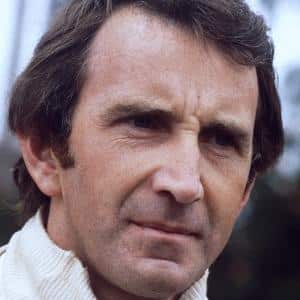‘Chocolate drop’ — the breathtakingly brown Chevron B26
A racing car, in that shade? Only in the 1970s. Yet to our eyes the Chevron known as ‘Chocolate Drop’ is still drop-dead gorgeous. Damien Smith tells its story

Jonathan Bushell
John Watson loved his Chevron sports car cameo. Especially his dalliance with this, the 2-litre B26 known universally as ‘Chocolate Drop’. Bizarrely, it was the second of two brown racing cars the future five-time grand prix winner would race 50 years ago in 1974. That colour… so 1970s. Yet you have to say, it really works. The car takes our breath away when we meet it, gleaming in the Thruxton sunshine.
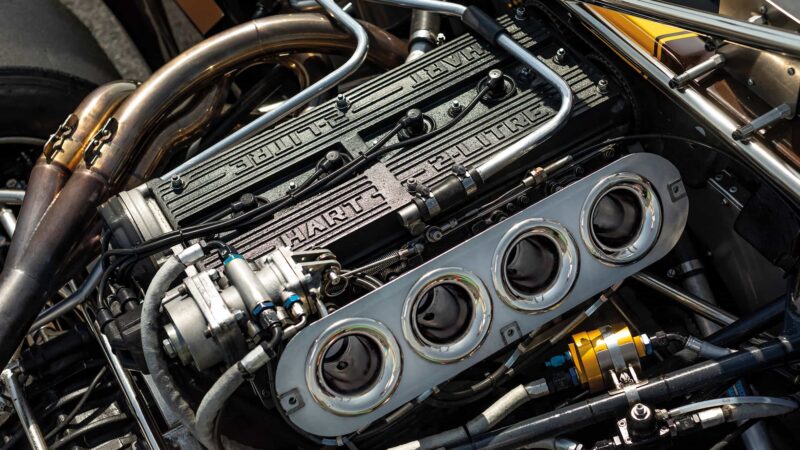
‘Chocolate Drop’ is once again reunited with Hart 420R.
Jonathan Bushell
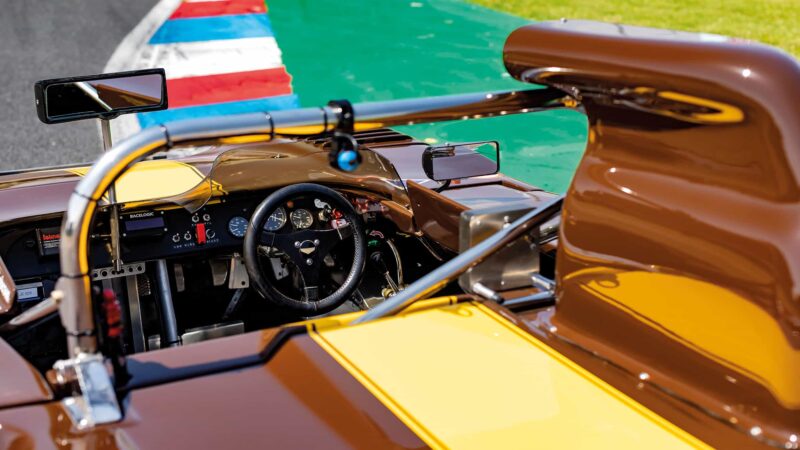
It doesn’t get more 1970s than this…
Jonathan Bushell
“The power, the weight, the balance, the grip – I thought it was really great,” says Wattie of his dip into Chocolate Drop at the Nürburgring 1000Kms in May 1974. Sharing with Chevron mainstay Peter Gethin, the pair qualified first in class and eighth overall against the works Matras, Alfa Romeos and Gulf Mirages and only lost the 2-litre prize in the closing stages of the race through a wheel bearing failure.
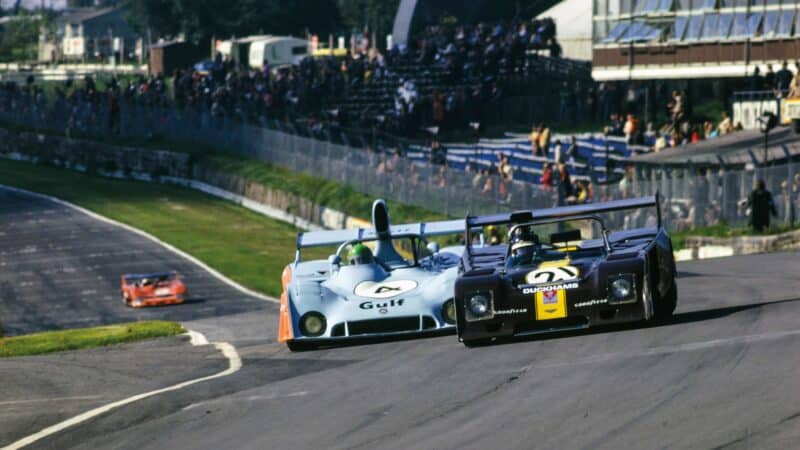
Reine Wisell’s Mirage chases Peter Gethin at Brands Hatch in 1974. Note the sparse crowd in the stands
Jonathan Bushell
“I’m far from being a Nürburgring specialist, but that car gave me my best experience of the Nordschleife,” asserts Watson, who used the experience to prepare for driving John Goldie Racing With Hexagon’s similar-shade Brabham BT44 at the German GP later that year. “The Chevron is the best race car I’ve ever driven at the Nürburgring, and that includes F1 cars. I was actually quicker than Gethin in qualifying which pissed him off. Peter had an ego and thought he was Mr Chevron – although there wasn’t very much in it. A year later I drove the [3-litre Cosworth-powered] Gulf Mirage, which I’d driven as a factory driver in 1973, for Georg Loos, an exuberant German character. I was barely 10 seconds quicker than I had been in the Chevron because it was so beautiful, nimble… confidence-inspiring. That was the underlying experience. I can’t think of anything better than a Chevron around the Nürburgring.”
“The Chevron is the best race car I’ve ever driven at the Nürburgring, and that includes F1 cars”
Chocolate Drop was sweet as they come, then. But you could also describe it as an iceberg of a racing car. By which we mean its frontline period career – the bit above the waterline that stands most prominent – turned out to be relatively short-lived. Yet beyond 1974, the depth of its history just stretches on… and on. Most novel was the period when it morphed from familiar, purposeful open-top sports racer into, of all things… a Skoda Super Saloon. Just the sort of madness you’d expect from the 1970s.
Long returned to its original Duckhams yellow-striped glory, Chocolate Drop today is owned by Chevron enthusiast and historic racer John Emberson, who shares it with seasoned pro driver Nigel Greensall in Peter Auto races around Europe. A spate of fastest laps and class wins have been logged in the past 12 months.

It doesn’t get more 1970s than this…
Jonathan Bushell
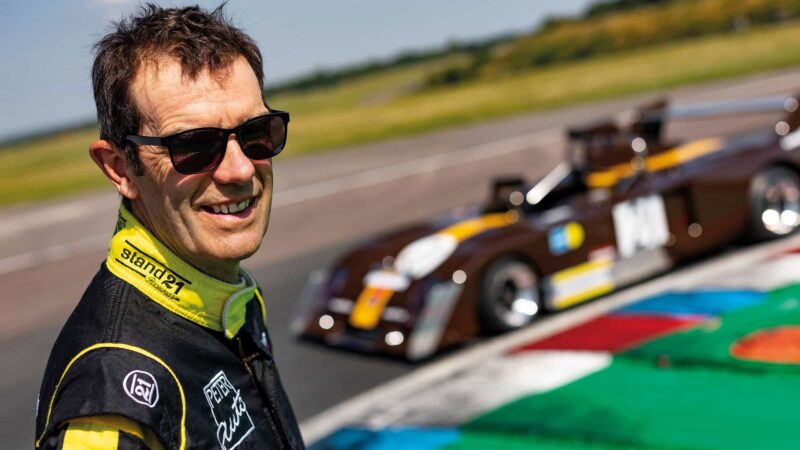
Nigel Greensall has been racing the B26 this year.
Jonathan Bushell
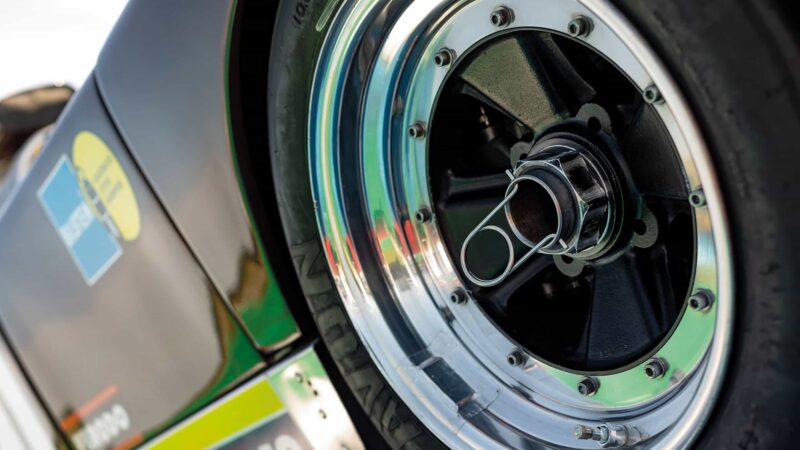
These wheels have spun at multiple Le Mans Classics
Jonathan Bushell
It’s Greensall who has arranged for the car to be here at Thruxton, on a sweltering summer’s day, for our photos. Chocolate Drop didn’t have to travel far. Simon Pragnell’s Foxcraft Racing, which tends to its every need, is based in nearby Stockbridge. So far in 2024, Emberson and Greensall have raced their brown beauty at Mugello, Spa, Dijon – where they claimed a class win – and Paul Ricard, with Estoril still to come. A pretty and potent sports car, driven on classic circuits, usually with a bit of sunshine thrown in – it’s not a bad racing life. “The Chevron is fantastic to drive,” confirms the ever-enthusiastic Greensall. His verdict concurs neatly with Watson’s from period. “Good race cars like this just inspire you to go faster and we’re now having some really wonderful races. At Dijon we were running as fast as the 3-litre cars and taking the fight to them. We can win our class but also challenge outright, which is causing quite a surprise.”
Then again, Chocolate Drop always was a smooth-as-velvet giant botherer.
It was all Brian Redman’s fault. Dismayed by the pace of Lola’s T210 spyder in the new European 2-litre series – sports car racing’s equivalent to Formula 2 – Lancashire’s finest cajoled his old ally from “the industrial north” to do something about it. The trouble was, Derek Bennett was busy. His Chevron B16 coupé was doing good business and he had cars to build for those pesky customers. Where would he find the time to build a weight-saving open-top version? Thankfully for Redman, and the 2-litre scene in general, the answer was by August. Chevron’s B16S proved highly effective.
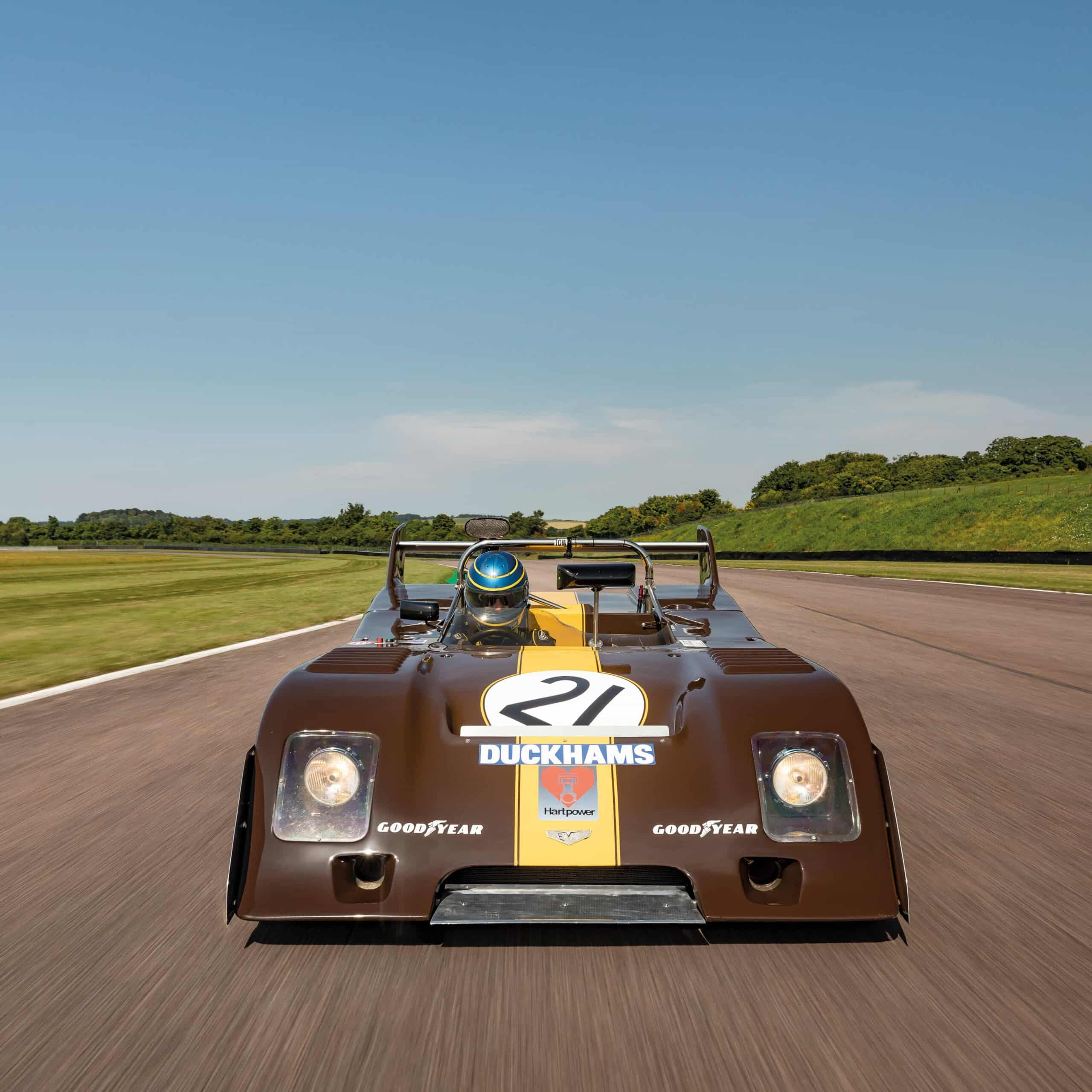
As the 2-litre category caught on, the B16 begat the B19, which begat the B21, which begat the B23… but by the end of ’73 Bennett’s simple spaceframes were starting to creak under pressure from Lola and Osella. So he went back to the drawing board for the next model, the B26 – the first of his sports cars to be built around an aluminium monocoque, with subframe to support the engine, gearbox and gearbox assemblies. Also included for the first time was an integrated large full-width rear wing.
“Good race cars like this inspire you to go faster and we’re now having some wonderful races”
Bennett himself shook down the new car, lapping Croft a remarkable three seconds faster than the spaceframe, wingless B23. A few weeks later the model took its competitive bow, Watson pairing up with South African local Ian Scheckter (brother of Jody) in a Gunston-liveried B26 in the Kyalami Nine Hours. An astonishing outright victory and defeat of Reinhold Joest and Herbie Müller’s 3-litre Porsche 908/3 was on the cards, until its Hart-Cosworth BDA overheated. But the duo did win the three-hour race at Killarney in Cape Town – by three laps over the second-place Lola T292, for Wattie’s first international sports car win. However, outside the motor racing bubble the world was in a degree of turmoil and the oil crisis scuppered the rest of the Springbok Series. Still, the South African campaign had proven the new Chevron’s worth – if racing still had a future. It did, even if the winter of 1973 into ’74 was tough, on everyone.
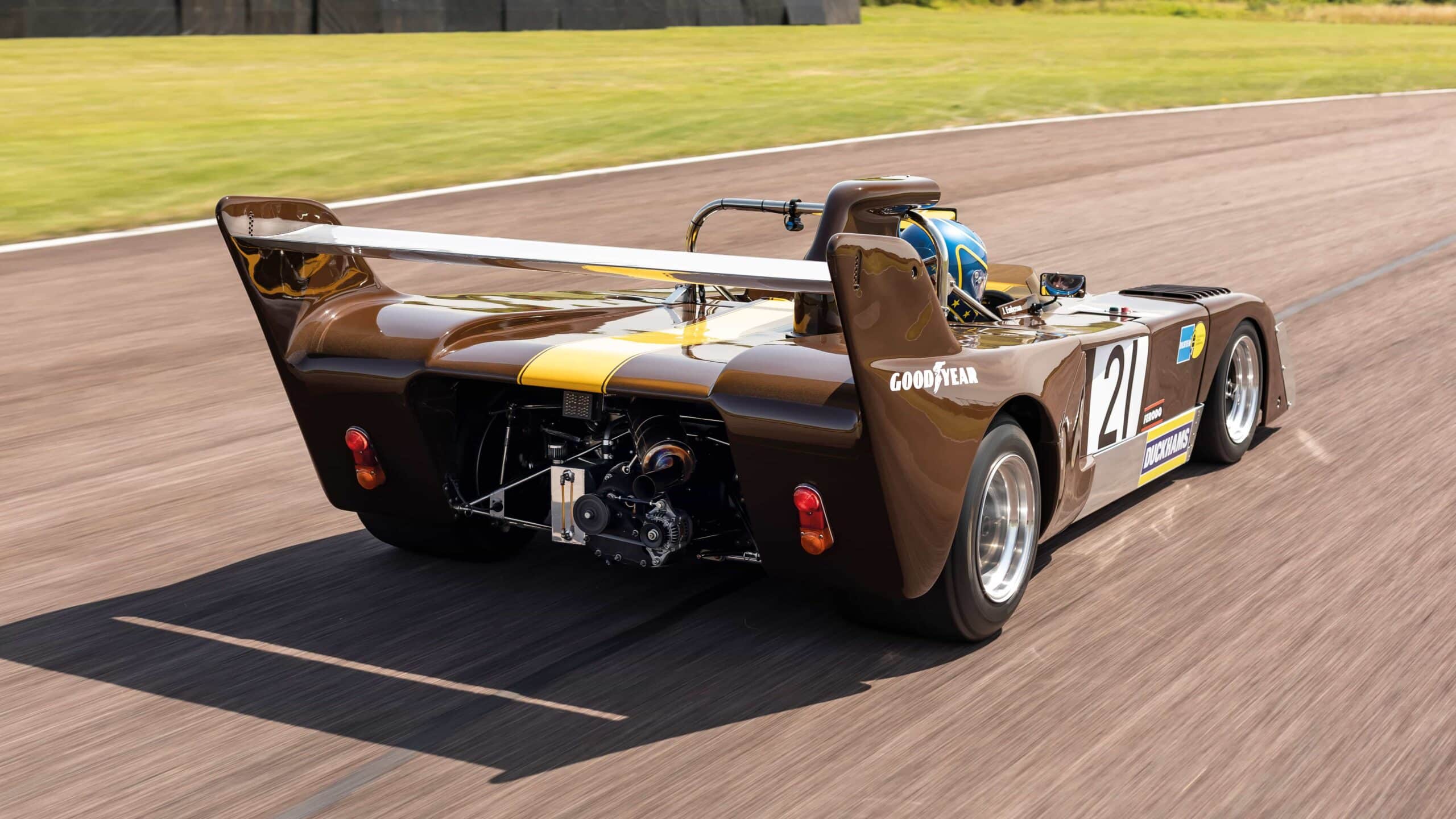
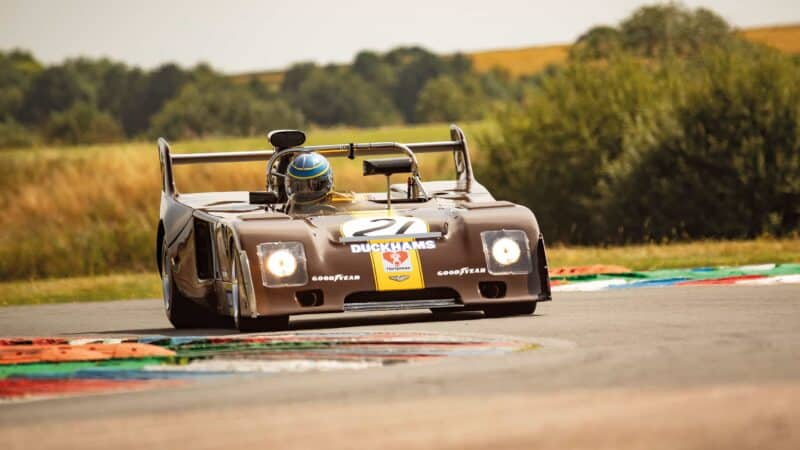
Chocolate Drop has history with Thruxton, being raced here in 1975 by then-owner Iain McLaren.
Jonathan Bushell
Chocolate Drop was stirred into existence in April 1974, the ninth and last B26 to be built – yet tagged as chassis B26-74-10. It stood out for two key reasons: first and most obviously, the colour; second, the pioneering engine that powered it.
The story behind the colour is a little murky. “There are various legends and it’s hard to know whether the wrong colour gel coat was selected or if it was for an abandoned sponsor,” says Simon Pragnell. Watson is nonplussed by his own association with brown. “I can’t give you an explanation. The Chevron was brown, so was the Hexagon Brabham I drove that year, and the first time I drove an F1 car – an Eifelland March at Phoenix Park in 1972 – it was owned by Tony ‘Monkey’ Brown. So there were three browns in my life. Also, I believe my grandmother on my father’s side was named Brown…” Not the obvious palette for a racing driver. Anyway…
“It’s hard to know if the wrong colour gel coat was selected or if it was for an abandoned sponsor”
“Chocolate Drop was the spare car, destined for another home,” says Pragnell. “That fell through, at which point Brian Hart offered his engine. By fluke it turned out to be the works car, and the success it enjoyed was the foundation for the B31 which are almost exclusively Hart-powered.”
The Hart association with Chevron had begun through US importer and entrant Fred Opert, who ran Hart twin-cam engines in his Formula B cars in 1969. Through success with alloy block Cosworth BDAs, the tuner spotted a hole in the market for a bespoke 2-litre alloy racing engine. That motor, 420R, would feature Hart’s own four-cylinder alloy block 16V head and boasted a 30lb weight saving and an apparent 15bhp power advantage over Cosworth’s BDA. Eventually the 420R would carry Hart to his greatest giant-killing successes as the BMW-defeating power behind Toleman’s European Formula 2 glory in 1980, which then swept the tuner into its audacious and infamous turbocharged Formula 1 years. But here in 1974, the development engine wasn’t yet eligible for F2 – but it was perfect for a 2-litre sports car. That’s when Hart approached Bennett and how Chocolate Drop became the pioneer beneficiary of 420R.
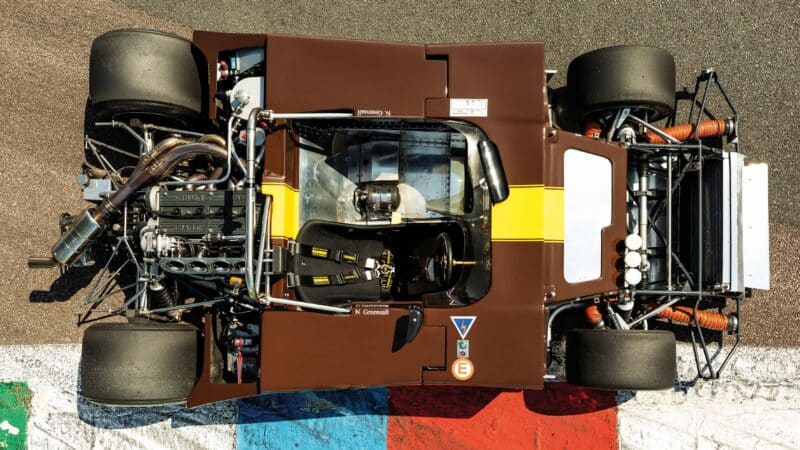
Stripped B26 shows its neat packaging
Jonathan Bushell
Gethin gave the car its race debut, in an Interserie round at Silverstone, where he finished fifth behind two Porsche 917/10s, a 917/30 and a McLaren M20. The Nürburgring Watson/Gethin appearance followed a week later, then John Lepp drove the car in European 2-litre – but the dominant works Alpine-Renaults were throttling the life out of the series. Chocolate Drop’s best showing was at Hockenheim in August, when Lepp finished second on aggregate, 0.8sec behind Alain Serpaggi’s Alpine-Renault. It’s said when he got back to the pits Hart and Bennett had left in disappointment.
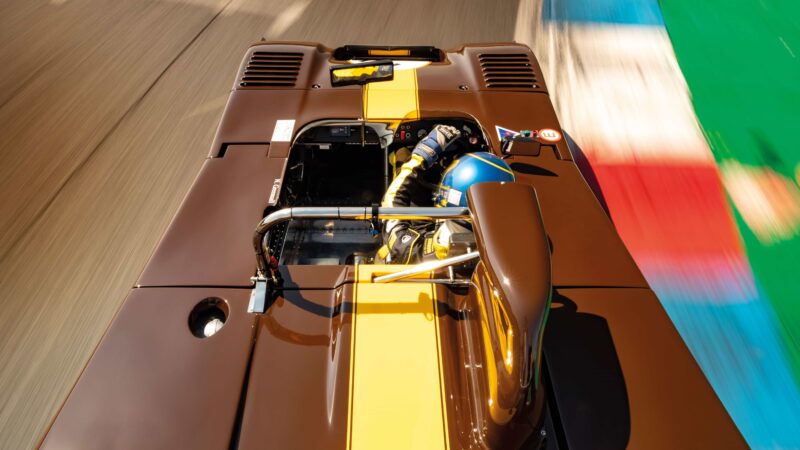
The distinctive Greensall helmet.
Jonathan Bushell
Chocolate Drop’s greatest moment followed a month later, when it took a starring role in the Brands Hatch 1000Kms, in which Gethin was paired with fellow Chevron totem Brian Redman – perhaps surprisingly, for the one and only time. They qualified fourth overall, just 0.2sec behind Derek Bell and David Hobbs in a Gulf Mirage, and more than a second faster than the next 2-litre class contender. Chocolate Drop got between the two works Matras from the start, then ran third – but lost eight minutes in the pits for a damper change. But this was fallow mid-1970s sports car racing… Gethin and Redman still finished fourth overall, nine laps down on the Matras, but just 38sec behind Bell/Hobbs. The next 2-litre car? It was 15 laps in arrears. No wonder fewer than 7000 spectators turned out to watch.
“Chocolate Drop’s greatest moment was a starring role in the Brands Hatch 1000Kms”
Still, Redman remembers it fondly. “It was a really great race,” he says. “We had a long pitstop, but still it was very good for Chevron. That was the only time I shared with Peter. He was very easy to get on with. In the last stint Brian Hart said, give it another 500rpm! The engine was great. It was a big improvement on what we had.”
Chocolate Drop ended its works season in Team Gunston orange and brown for the final WSC round at Kyalami, Gethin sharing with Ian Scheckter. Fifth overall in qualifying, again on the heels of the 3-litre DFV Gulf Mirages, the Hart let them down in the race. Still, Chevron was fifth in the manufacturers’ championship.
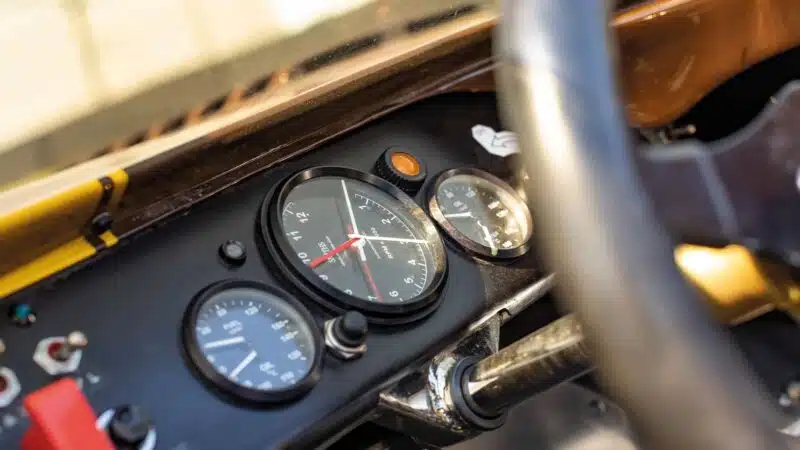
Hart power gave a few more horses than the BDA.
Jonathan Bushell
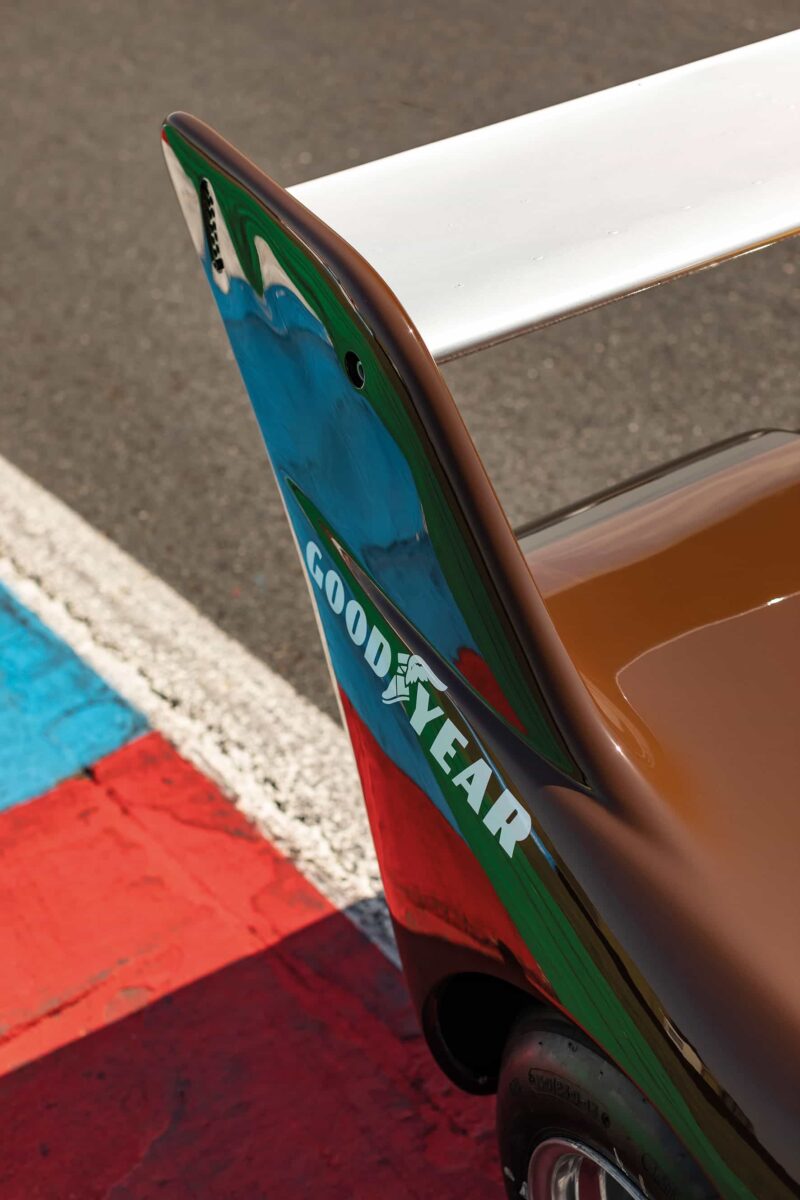
As much use as a chocolate spoiler
Jonathan Bushell
From there, Chocolate Drop’s weaving odyssey to the present day begins. Scot Iain McLaren bought the car in 1975 and campaigned it over two seasons with a Hart-prepared Cosworth, winning the British Sportscar Championship in 1976.
Sold to Richard Philip and Alan Sharpe in 1977 and now obsolete in terms of contemporary sports car racing, the B26 underwent its metamorphosis into a Skoda Super Saloon. Jim Price first raced the Skoda at Donington in March 1980, then passed it on to Walter Robertson in early 1981 for whom Colin Bennett Racing ran the car.
Chocolate Drop was born again in its original B26 form during the late ’80s under Mike Pendlebury’s watch. The work was completed in 1991 with input from original Chevron mechanics, after which it passed through various hands, was reunited with 420R power and became a popular sight at the Le Mans Classic. Emberson now cherishes one of the best-known Chevrons from Derek Bennett’s unpretentious hand.
“We rebuilt it in 2019-20,” says Pragnell. “Cosmetically it was almost there, it just needed some love on the underpinnings. You must be respectful to its originality, even with certain modifications for driver comfort and safety compliance.”
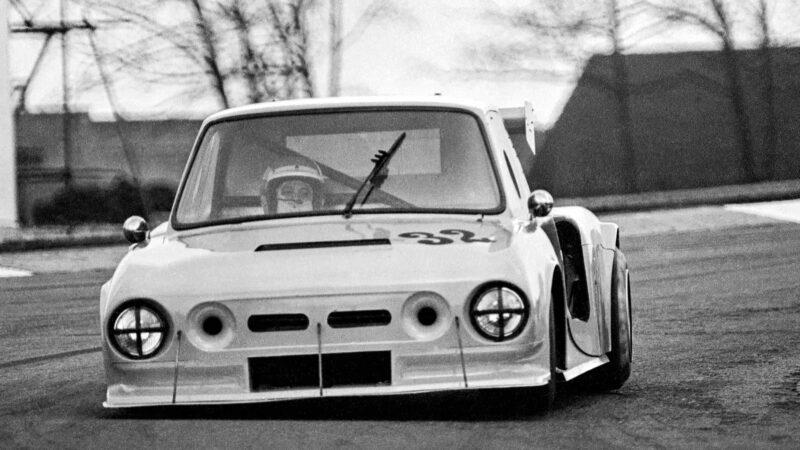
From Chocolate Drop to Skoda Super Saloon. This is Walter Robertson at Donington in 1981
McKlein
Pleasingly, he found “signs of yellow paint” from its Skoda Super Saloon days. “It’s had a hard life. But when we’re out racing people approach to say they remember the car. These are strong cars with their triangulated chassis, and your feet are kept back far enough away from the action. They kept that characteristic bolt-on nose frame with racing and quick maintenance in mind when they made the B26. It’s well-designed and a true drivers’ car.”
Over the past couple of years, Greensall has worked with Pragnell on behalf of Emberson, a serial Chevron owner and enthusiast. “The prime requirement was to make it driveable and confidence-inspiring for John,” says Nigel. “We’ve gone on a nice journey to make it well-balanced and he now loves driving the car. That’s the reward.”
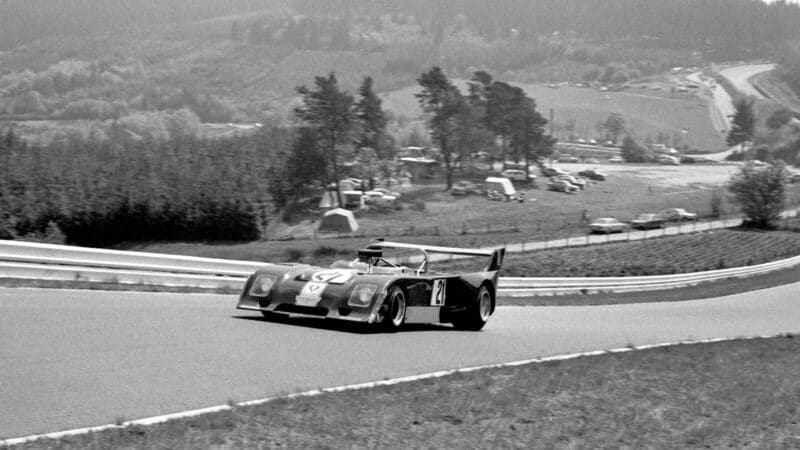
Nürburgring, 1974 – the brown Chevron’s WSC debut with Gethin pairing with John Watson
Getty Images
All agreed only a Hart 420R would do. over a BDA. “We stuck with the Hart when some told us to put it in a box,” says owner Emberson. “It did take some time to make it reliable and we still had some problems at Mugello. It doesn’t seem to like the period electronics we are asked to use, which don’t like the wet or the heat! But since then it has proven much more reliable and we are seeing why it should be quicker than a B19.”
At 50 years young, Chocolate Drop is still as sweet as they come.
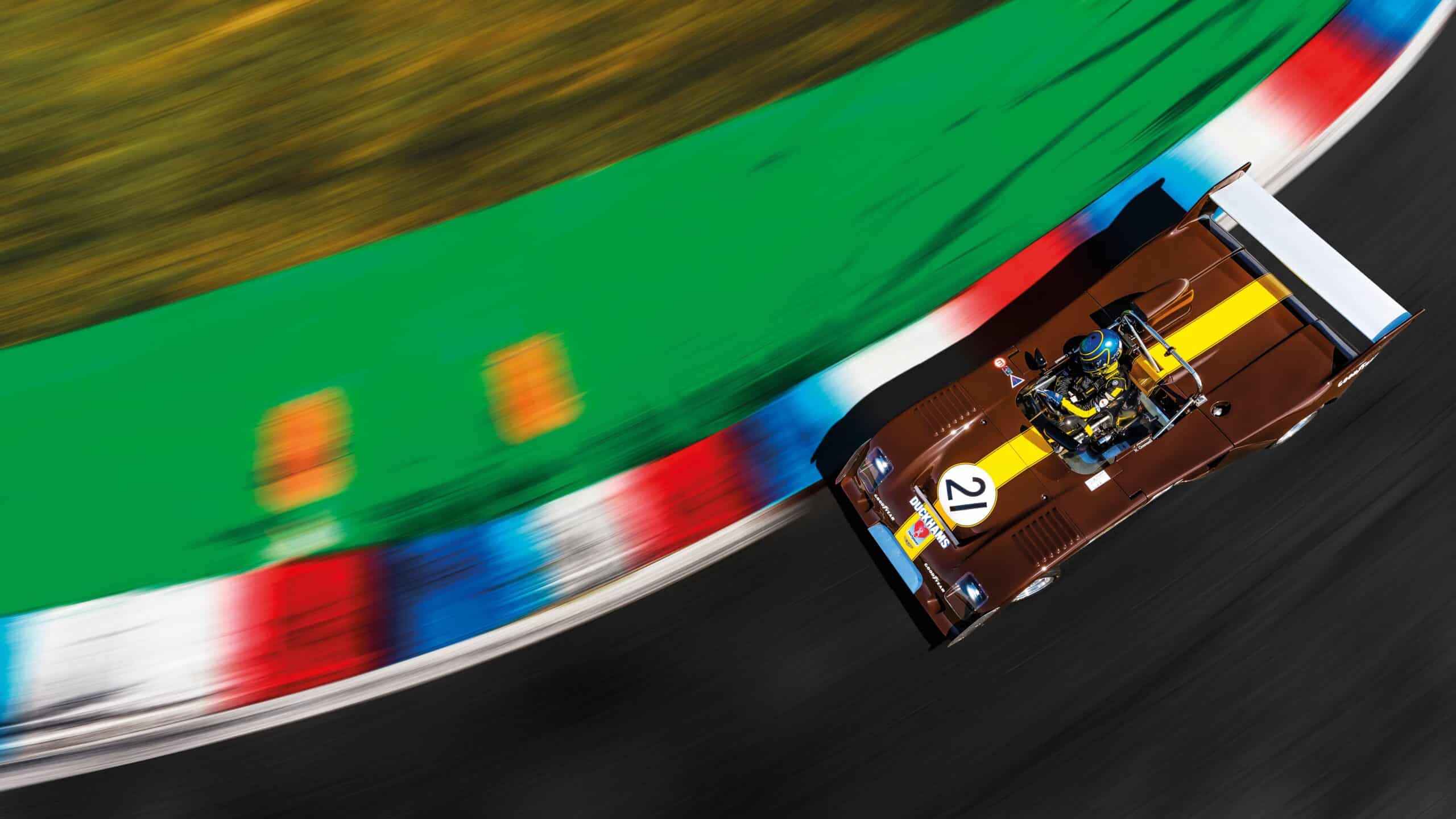
1974 Chevron bB26
Chassis Aluminium monocoque
Engine Hart 420R 2 litres, four cylinders
Power 300bhp
Transmission Hewland FG400 5-speed transaxle
Weight 550kg (ballasted to 600kg for current regulations)
Our thanks to Thruxton Circuit, for use of the track, John Emberson, Simon Pragnell at Foxcraft Racing and Nigel Greensall.
